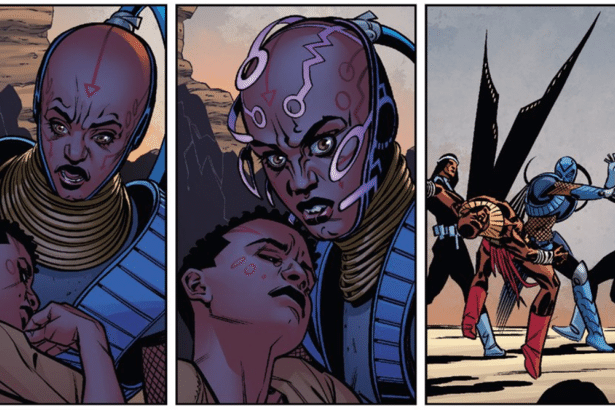Sam Ombiri riffs on Henry Darger and Hideo Furukawa, and Sally shares updates from the Fifth Annual Black Comic Book Festival and other comics news!
—————————————————————————————————
Sam Ombiri here: I’ve really been into this Henry Darger documentary – The Realms of the Unreal.
It’s really good. There’s this amazing part where they are recounting a time when Henry lost one picture – one that I think was one of his main references for drawing the girls. (Editor’s Note: “The girls” are the Vivian Girls, characters in Darger’s 15,000 page fantasy novel The Realms of the Unreal.) He held [the drawing] in such high regard that the story changes as a result, and he punishes his characters until he can find the picture. That part was amazing. I kind of skipped all over the place as a result of my low attention span, so I don’t remember where it was. I think my attention span wass also lowered because this documentary reminded me of the ones I’d see in elementary school that I wouldn’t pay attention to.
At times I feel Henry Darger would purposely lie to himself in order to go through with a certain aspect of the story, and then get away from that lie. At least I’d like to think that, but maybe I’m the one doing that. There’s a part in this video where Jesse Moynihan talks about how there’s still power in rearranging history and things aren’t tied down to one telling.
Or in what feels like a similar spirit, Hideo Furukawa, who is known for sometimes writing remixes of already written books, says “Music can be divided into melody and the rest, and you can take out either of them separately. If you take out the former, you “cover” that music; if you take out the whole of the latter, you “remix” it. Likewise, fiction is divided into the narrative and the rest.”
At the beginning of his novel Belka Why Don’t You Bark he puts at the beginning, “Yes I admit this is fiction but then what isn’t?” He also put after that, “This book is dedicated to Boris Yeltsin; Hey Boris I know your secret!”
Hideo continued, “The narrative needs some vehicle, which is provided by different storytellers each age. In other words, the same narrative can change their vehicle, and in that sense the simple re-telling (covering, you might say) is always possible. Remixing is, for me anyway, an attempt to go beyond that, to take the whole of the preceding work.”
Hideo Furukawa is someone who’s often referred to as a chameleon for doing all kinds of experiments with the way he writes his books. (Side Note: I like CF’s idea that experimenting just means not taking yourself seriously and that you go into a state where the ordinary laws of creativity don’t apply. I think it’s what he said.)
Here’s one experiment Hideo Furukawa did, for example: There’s this book called Tribes of Arabian Nights that takes place in Cairo. Because there were more and more books coming into Japan that needed to be translated, he claimed that he didn’t write the novel, he was just translating it. (At least that’s what I think could be his reason. This is just speculation on my part – this was the automatic reason that formed in my mind. The more I think about it though that’s like every country.)
I’m not too sure what Hideo’s remixes are like. Thankfully there’s gonna be one that’s being released in English in June which I’m excited to read. Although, I’d rather just read one of his actual novels. I read part of something he did for Tale of Genji, but it wasn’t strictly speaking a remix – it wasn’t a retelling. To my knowledge it doesn’t have the same rules as his remixes. For one thing, he re-titled it 300 Treacherous Women, instead of Tale of Genji Remix (which would make for a pretty hilarious title. My one friend was telling me about how this musician who I think is part of the Brainfeeder collective recorded Pomegranates by Parajanov. My immediate reaction was ha ha oh no!) Hideo’s version of the story was more based on a ghost coming and proclaiming how, until the story was modified back to how it actually happened, this one woman would keep giving unrest to this other woman. I assume his remixes are different.
Hideo said, “For the remix of Kenji Miyazawa’s The Bears of Mount Nametoko the bears appear in the ‘Mount Nametoko’ story. In Japan bears are something of a deity, reigning over the mountains (the natural world). They don’t appear in towns (the human world). Hunters, however, play the role of mediators, and turn part of the mountains into commodities, which are circulated in the towns. What we witness here is the violent contact between nature and man. We are made to face the fact that bears are something which are not cattle but are eaten, and humans allow themselves to take something out of nature to keep themselves alive in this world. Kenji Miyazawa, as author Kenji, kept writing about this staggering fact. When Japan was violently attacked by nature in 2011 (the year of the Great East Japan Earthquake), I thought I, as author Hideo Furukawa, had to retell those stories written by Kenji. I could re-tell the stories, precisely because Kenji had already told them.” – Sam Ombiri

—————————————————————————————————
Sally here – Over on Vice there’s a video of Ronald Wimberly speaking at the Schomburg Center during the Fifth Annual Black Comic Book Festival. Wimberly tells us about growing up in D.C., his new book, and what it means to have black representation in comics. Check it out HERE (watch the full episode of ‘Daily VICE’ on go90.)
There was a nice write-up of the Fifth Annual Black Comic Book Festival (which took place Jan. 13th and 14th 2017) on Okay Africa – it includes lots of pictures!
Even better than pictures, The Blerdgurl offers up Part One of her interview series with creators at the Black Comic Book Festival this year – check it out below!
—————————————————————————————————
The Comics Reporter draws our attention to a treasure-trove of Ta-Nehisi Coates‘ thoughts about writing The Black Panther, posted on The Atlantic – HERE. From his interest in the Dora Milajae – the all-female troop of bodyguards to the King – and how he uses them to talk about feminism in the story, to the poetry that opens and closes issue #3, to his thoughts on Alan Moore’s Swamp Thing, there’s a lot of interesting stuff to unpack.
—————————————————————————————————
From the Comics Workbook TV archives – Bill Boichel riffs on Jackie Ormes. She was the first African-American woman to be a syndicated cartoonist. She is one of the nominees for this year’s Will Eisner Hall of Fame inductees.
—————————————————————————————————
Announcing the Spring Semester of thee Santoro Correspondence Course for Comic Book Makers!
The course starts March 7th 2017. Apply by February 26th to get 100 bux off! The course is 8 weeks long – payment plans are available.
Application guidelines:
– 3 figure drawings done on blank 3 x 5 index cards
– 3 landscape drawings done on blank 3 x 5 index cards
– 3 still life drawings done on blank 3 x 5 cards
– draw in a contour line style –think Matisse – no under-drawing
– draw directly in ink
– just send me small jpgs of images – dont post to your blog pls
– send specific url links to any comics work you have done. If you haven’t done comics before that is not a problem.
Email santoroschoolATgmail to apply! More details HERE.
—————————————————————————————————
Blinkers – 2-16-2017 – by Jack Brougham
—————————————————————————————————
Suzy and Cecil – 2-16-2017 – by Sally Ingraham
—————————————————————————————————
Joanie and Jordie – 2-16-2017 – by Caleb Orecchio
—————————————————————————————————
Cozytown – 2-16-2017 – by Juan Fernandez






